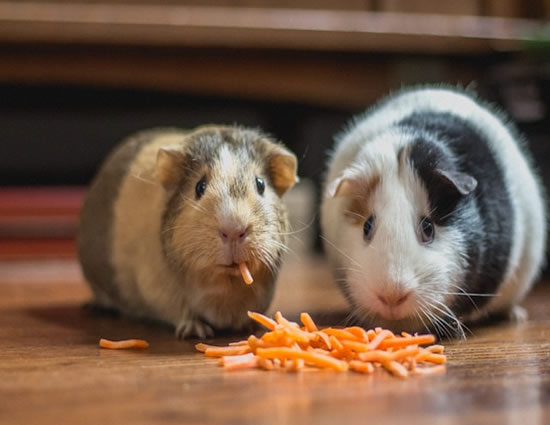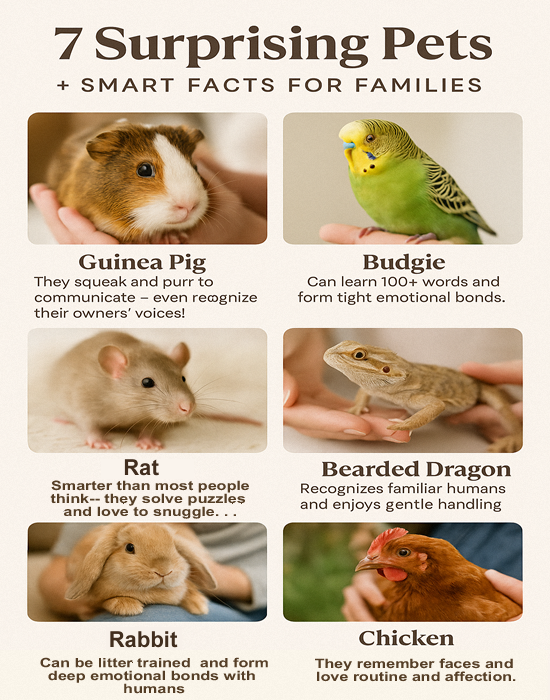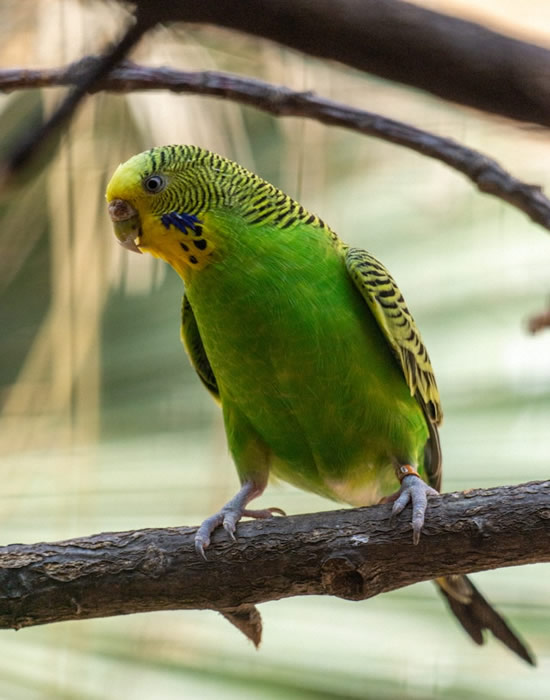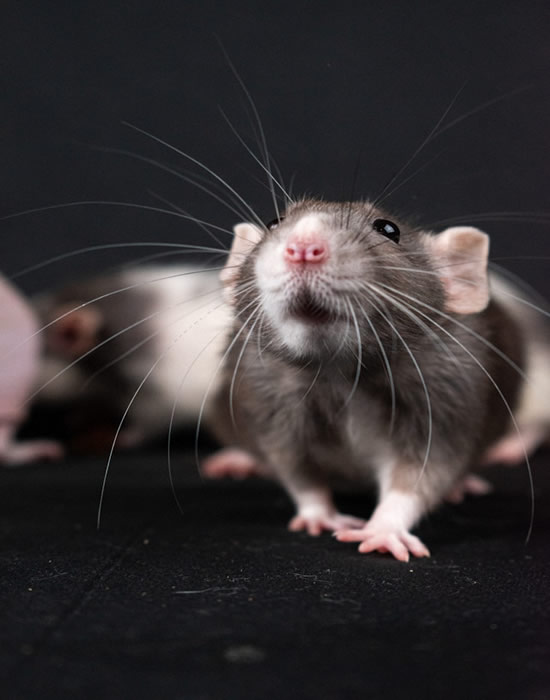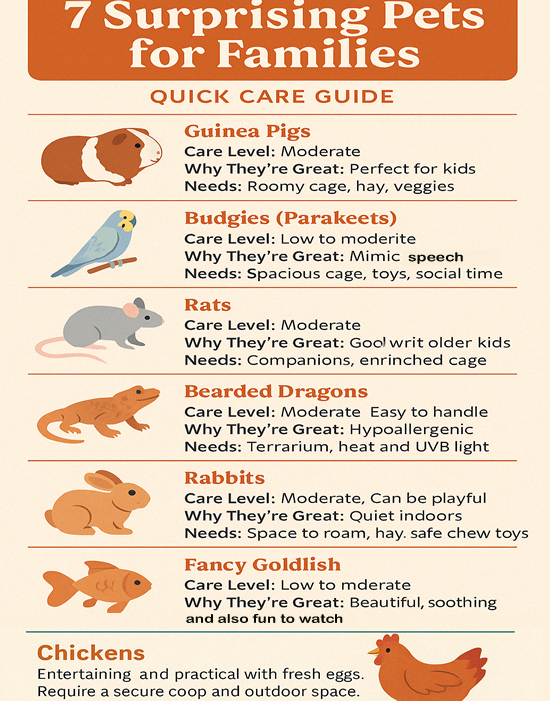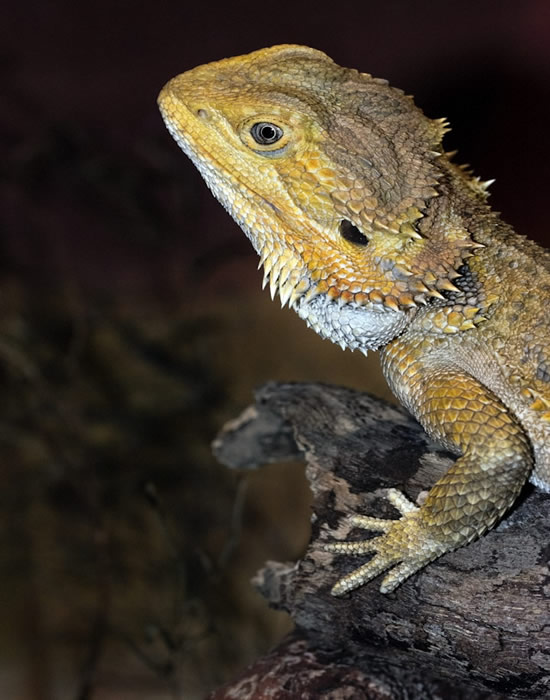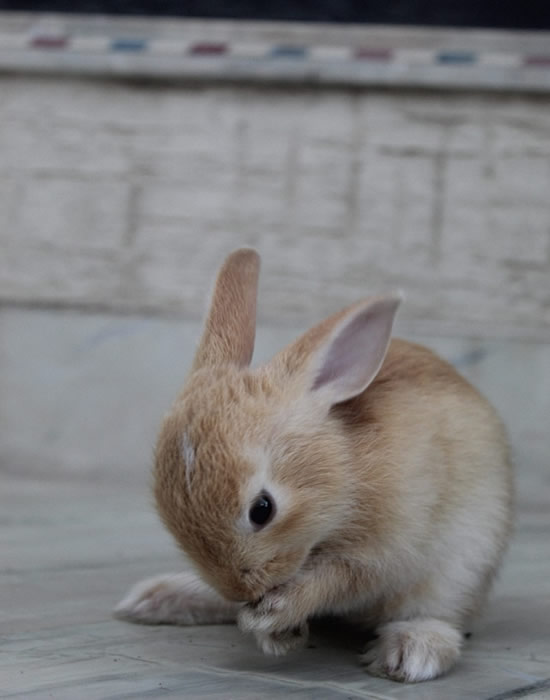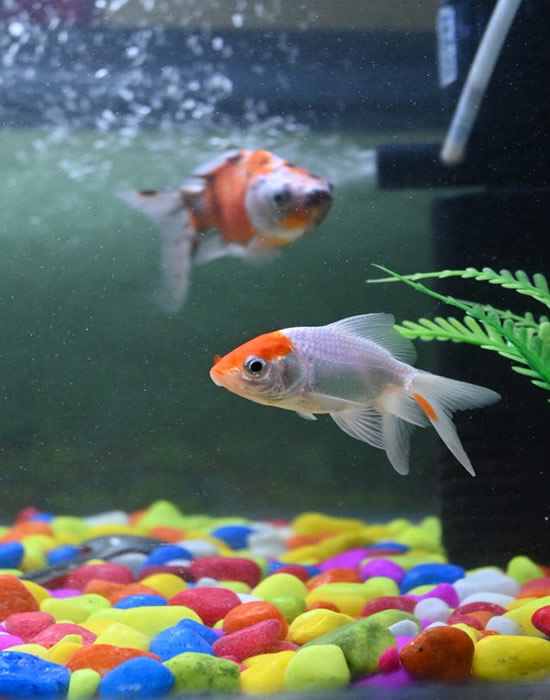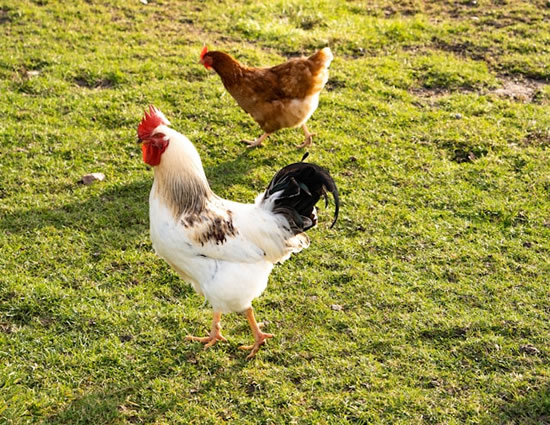7 Great Pets for Family You’d Never Guess Belong in Every Home

When people imagine ideal pets for family life, dogs and cats are usually the first to come to mind — and rightly so. They’re loyal, affectionate, and widely recognized for their companionship. But as more families explore alternative lifestyles or live in smaller spaces, the range of pets being welcomed into homes is expanding. These days, families are discovering that the perfect pet might have feathers, scales, or tiny paws, rather than fur and a bark.
According to the American Pet Products Association, nearly 70% of U.S. households own a pet. And within that number is a growing trend toward non-traditional companions. From cuddly rodents to highly social reptiles, these unique pets offer families emotional connection, learning opportunities, and joy that’s just as powerful as a wagging tail or a purring lap nap.
So, if you’re curious about something different — something that fits your lifestyle while teaching kids empathy, responsibility, and gentleness — here are seven pets for family living that may surprise you with just how perfect they can be.
What Every Family Should Know Before Choosing a Pet
Before diving into the exciting world of unexpected pets for family life, it’s essential to pause and consider the responsibilities that come with bringing any animal into your home. Choosing a pet isn’t just about finding something cute or entertaining — it’s about committing to their care, health, emotional needs, and long-term happiness. Whether you’re looking at traditional pets like dogs or exploring more unique options like bearded dragons or chickens, preparation is key.
Families often overlook the importance of early preventive care, especially when it comes to animals like puppies and kittens. If you’re leaning toward adopting a dog, understanding the full schedule of dog vaccinations is one of the most critical first steps. Vaccinations help protect your pet from dangerous diseases and ensure they grow up healthy — which in turn protects your family as well. It’s all part of building a nurturing and safe environment where your pet can truly thrive.
Being mindful of these foundational responsibilities makes it easier to match the right pets for family dynamics, especially when kids are involved. The goal is to create a relationship that’s enriching for both your loved ones and the animal you welcome into your world. And once you’ve laid that groundwork, you’ll find that even the most unconventional pets can bring incredible joy, learning, and love into your home.
Guinea Pigs – The Snuggly Chatterboxes
Guinea pigs are often underestimated, but they’re among the friendliest and most expressive small pets available. They have gentle temperaments and thrive on interaction. These little creatures communicate through a range of squeaks and chirps, showing clear excitement when they hear their humans nearby. Their vocal responses and physical closeness make them perfect for teaching younger children about emotional connection and routine care.
Unlike some small animals that may be jumpy or skittish, guinea pigs are calm and welcoming when treated kindly. A University of Lincoln study found that guinea pigs tend to be less stressed by handling than rabbits, making them ideal for families with small children. They do require a clean cage, constant access to hay and vegetables, and daily attention, but their responsiveness and emotional presence make the effort deeply rewarding.
- Fun fact. Guinea pigs “popcorn” when they’re happy — bouncing in the air like kernels on the stove!
- Care Level. Moderate. They need daily hay, veggies, and clean bedding — but no walks, no scratching posts, and no fuss.
Budgies (Parakeets) – The Colorful Conversationalists
Budgies, also known as parakeets, are small in size but full of life. They’re intelligent birds that love to interact, mimic speech, and engage with their families in very personal ways. When given consistent attention and care, budgies form bonds that rival those of more traditional pets. Their colorful feathers brighten any room, and their cheerful chirps add music to everyday moments.
What makes budgies particularly valuable for families is their social intelligence. Studies published in Animal Cognition show that budgies can use memory and social cues to solve problems, which can be enriching for children who love verbal and mental stimulation. They thrive with a spacious cage, toys, and daily time outside of their enclosure to stretch their wings and interact. They’re particularly suitable for homes that enjoy conversation, energy, and gentle companionship.
- Fun fact. A well-socialized budgie can learn 100+ words — and may become your child’s most talkative friend.
- Care Level. Low to moderate. They need a spacious cage, daily social time, and fresh water/food — plus toys to stay stimulate.
Rats – The Genius Snugglers
Despite persistent myths, rats are some of the cleanest, smartest, and most affectionate pets around. They form strong bonds with their owners, recognize their names, and even enjoy cuddling in pockets or sitting quietly on shoulders. For children who want a highly interactive pet, rats are both entertaining and emotionally responsive.
Rats are known to be empathetic. A study from Humboldt University demonstrated that rats will help their cage mates even when there’s no obvious reward, suggesting a depth of emotion rarely attributed to small pets. They enjoy solving puzzles, playing with toys, and spending time outside their cages in safe environments. They’re best kept in pairs or small groups due to their social nature, and they thrive when given daily attention, clean housing, and enrichment activities.
- Fun fact. Rats “giggle” — their laughter is ultrasonic, so we can’t hear it, but they laugh when tickled.
- Care Level. Moderate. They need a clean cage, daily social time, and companions (rats do best in pairs).
Bearded Dragons – The Zen Masters
Bearded dragons might look like tiny dinosaurs, but their personalities are calm, patient, and surprisingly affectionate. They’re among the most docile reptiles, and when raised with consistent handling, they often grow fond of human interaction. Families looking for a hypoallergenic, quiet companion often find bearded dragons to be ideal.
These reptiles respond to familiar faces and develop routines, creating a comforting presence in a household. Reptile behavior studies have shown that bearded dragons exhibit social awareness, often reacting to human gestures and even mirroring behaviors in some cases. Their care involves a terrarium with proper lighting and heat, a balanced diet of greens and insects, and regular handling to maintain their tame demeanor. For families with curious children and a steady rhythm, a bearded dragon can bring a calm kind of joy.
- Fun fact. Beardies can recognize their owners and will often watch TV alongside you like a scaled couch potato.
- Care Level. Moderate. They need a proper terrarium with UV light and a diet of greens and insects — but they’re quiet, clean, and endlessly fascinating.
Rabbits – The Hoppy Homebodies
Rabbits are soft, expressive, and capable of deep connection with their families. While many assume rabbits are simply quiet pets that sit in cages, the truth is that they can be litter trained, roam freely in bunny-proofed areas, and even follow their favorite humans around the house. When they trust you, rabbits show affection through nudges, grooming behaviors, and calm closeness.
They thrive in environments where they can establish routines and feel secure. The House Rabbit Society emphasizes that rabbits, when kept indoors and treated with the same attention as a cat or dog, live longer, healthier, and far more engaging lives. Their care requires space, a steady supply of hay and vegetables, and protection from hazards like electrical cords. In return, they offer companionship that’s serene, loyal, and profoundly grounding.
- Fun fact. Rabbits do a joyful twist-and-hop called a “binky” when they’re excited — and it’s pure happiness in motion.
- Care Level. Moderate. They need room to roam, safe chew toys, and daily interaction — but they’ll reward you with snuggles and silly antics.
Fancy Goldfish – The Mindful Floaters
Goldfish may seem simple at first glance, but their beauty and behavior have a unique emotional effect on the home. The peaceful movements of a goldfish swimming gracefully through its tank can provide therapeutic benefits for children and adults alike. In fact, a study from the journal “Environment and Behavior” showed that watching fish for even 10 minutes can reduce anxiety and lower blood pressure.
For families with children who need calm, visually stimulating environments — such as those with ADHD or sensory sensitivities — fancy goldfish can be the perfect first pet. They require a properly sized aquarium, ideally 20 gallons or more, with clean water and regular maintenance. While they don’t cuddle or interact like other pets, the mindfulness and sense of care they bring to a home are just as meaningful.
- Fun fact. With the right tank and care, goldfish can live over 10 years — some even outlive childhood!
- Care Level. Low to moderate. They need clean water, proper filtration, and a decent-sized tank — no sad little bowls, please.
Chickens – The Backyard Entertainers
More than just producers of fresh eggs, chickens bring personality, humor, and routine to a family’s daily life. Each chicken has its own quirks, preferences, and social behaviors, and when raised with care, they can become surprisingly affectionate. They provide a constant source of outdoor interaction, especially for children learning responsibility.
Chickens are intelligent animals capable of recognizing up to 100 faces, both human and animal. They remember positive and negative experiences, creating trust with consistent caretakers. Families who keep chickens often find themselves spending more time outdoors, learning about sustainable food sources, and developing deeper appreciation for nature. A secure coop, proper feed, and clean water are essential, along with checking local laws to ensure backyard chickens are allowed.
- Fun fact. Chickens remember faces — and they can even learn their names and come when called.
- Care Level. Moderate to high. They need a coop, regular cleaning, and predator protection — but the entertainment and fresh eggs are worth it.
Takeaway Bullet Points
- The best pets for family life aren’t always the traditional choices such as dogs and cats.
- Uncommon pets offer unique bonding, learning, and emotional rewards.
- Consider your home size, children’s ages, and time commitment before choosing.
- Embrace variety — love comes in all shapes, sizes, and species.
Final Thoughts
Choosing the right pets for family life means thinking beyond the usual suspects and considering companions that might once have seemed unlikely. Whether you live in a city apartment or a rural home, there’s a perfect pet that matches your family’s rhythm, energy, and needs. These unexpected animals — from intelligent rats to peaceful goldfish — bring joy, responsibility, and love into the home in ways that are refreshingly different.
Exploring these alternatives expands your understanding of what companionship looks like. It’s not always loud barks or soft purrs; sometimes it’s a quiet flutter, a curious gaze, or the warm presence of a creature resting beside you. As more families seek connection and comfort, these pets show that love comes in many forms — all equally powerful.
FAQs
1. Are these pets safe for small children, especially toddlers?
Yes — but supervision is essential. Guinea pigs, goldfish, and rabbits are gentle enough for toddlers with guidance. Animals like rats and bearded dragons are better suited for slightly older children who understand how to handle them gently. Teaching children how to respect animal boundaries is the foundation of a safe, happy relationship.
2. What is the most low-maintenance pet on this list for a busy household?
Fancy goldfish or budgies are typically the lowest maintenance. They require daily feeding and occasional tank or cage cleaning but need less hands-on interaction than mammals or reptiles. However, “low maintenance” should never mean “no attention.” Every pet thrives on consistency and care.
3. Can these pets live comfortably in an apartment?
Absolutely. Most of the pets listed here — guinea pigs, budgies, rabbits, rats, and even bearded dragons — are well-suited to apartment life. Just make sure to provide appropriate space, cleanliness, and enrichment. Chickens are the only ones that require outdoor access, so they’re best suited for suburban or rural homes.
4. Which of these pets are actually cuddly and emotionally affectionate?
Guinea pigs, rats, rabbits, and even bearded dragons can form strong, affectionate bonds with their humans. Rats, in particular, are highly interactive and love to snuggle. While animals like birds or reptiles might not cuddle in the traditional sense, they absolutely show affection in their own unique ways — from head tilts to chirps to relaxed body language.

